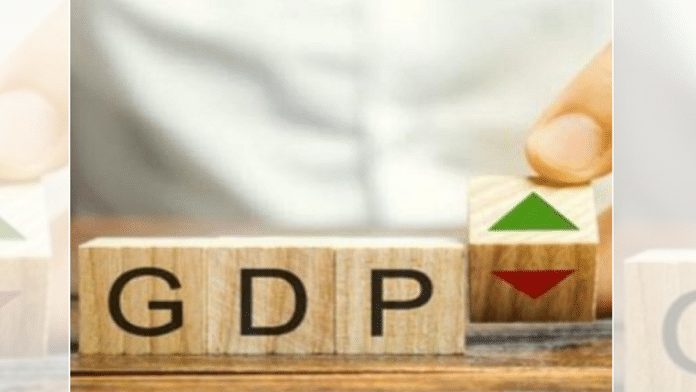Thank you dear subscribers, we are overwhelmed with your response.
Your Turn is a unique section from ThePrint featuring points of view from its subscribers. If you are a subscriber, have a point of view, please send it to us. If not, do subscribe here: https://theprint.in/subscribe/
Today, countries are competing to boost their Gross Domestic Product (GDP) numbers. Nevertheless, in this pursuit of economic growth, we often overlook what truly matters—happiness. GDP tells us how fast we are driving, but it does not tell whether we are heading in the right direction or if the passengers are even enjoying the ride.
Consider two road trips. The first is lavish—taken in a luxury SUV, filled with five-star stays, hot-air balloon rides, and gourmet meals. Every expense contributes to GDP and reflects visible economic activity. The second is humbler—an old car packed with close friends, roadside snacks, nights under the stars, and spontaneous detours to hidden gems. It barely registers on economic indicators. Yet as I sit by the bonfire laughing with friends, I realize that this modest trip offers more profound joy and connection. The contrast is telling: rising GDP might celebrate the first trip, but it completely misses the quiet fulfillment of the second.
The World Happiness Report 2025 ranks countries beyond GDP, and the contrast is striking. The United States, with the world’s highest GDP at $30.5 trillion, ranks only 24th in happiness. India, now the fifth-largest economy with a GDP of $4.2 trillion, stands at a worrying 126th. Meanwhile, Finland—with a modest GDP of $320 billion—tops the happiness chart for the seventh year. Denmark, Iceland, Sweden, and Israel follow—none are among the largest economies. These nations invest in public goods like healthcare, education, and transport, foster trust in institutions, promote work–life balance, and ensure citizen participation. Their example shows that even small economies can deliver immense happiness when dignity, equality, and support are in place.
Eminent economists and thinkers have long questioned the over-reliance on GDP as the sole index of wellbeing. Nobel laureate Amartya Sen reminds us that “income is one thing, but human beings’ ability to live the life they value is another.” Similarly, Robert F. Kennedy famously said, “GDP measures everything… except that which makes life worthwhile.” The Easterlin Paradox shows that as nations grow richer, their citizens do not necessarily become happier—a finding further validated by Daniel Kahneman, whose research shows that happiness increases with income only up to a point (~$75,000 per year), after which it plateaus.
In addition, Karl Polanyi, in The Great Transformation, warns that unchecked market expansion in pursuit of GDP can erode the social fabric—a trend visible today, where digital spaces often displace real human connections, and families and communities grow more fragmented. These perspectives emphasize the complexity of measuring wellbeing and the need for more holistic, multidimensional metrics.
India’s low ranking should concern us—not because we need to climb another global list, but because it signals a disconnect between material progress and human development. Our cities are expanding, digital infrastructure is growing, and global investment is pouring in. But at the same time, we witness rising stress, loneliness, income disparity, and ecological degradation.
Are we driving faster while ignoring that the tyres are thinning and the passengers are weary?
This is not an argument against GDP. Growth is essential to lift people out of poverty, build infrastructure, and promote innovation. But GDP is a means, not an end. Policymaking should focus on “what makes life worth living,” not just what makes money flow.
Incorporating happiness into public policy is no longer utopian—it is happening globally. New Zealand has adopted a “Wellbeing Budget.” Bhutan uses Gross National Happiness (GNH) as its primary policy lens. Scotland and Iceland are embracing alternative indicators to guide decisions on health, climate, and education. It is time India joins this conversation seriously.
We could start by including wellbeing indicators in our national economic surveys, developing state-level happiness indices, and tracking mental health and social trust as key performance indicators—not just road length and electricity coverage.
Let us ask ourselves: What kind of India do we want to build by 2047? One that is just richer, or one that is happier, more compassionate, and more sustainable?
As the Indian economy aspires to reach the $10 trillion mark, the question is not whether we will get there—but what kind of country we will be when we do. Will we be a nation with swelling bank accounts and hollow hearts? Or can we aspire for both—prosperity and peace of mind?
GDP is a good servant but a poor master. It can count the cars on the road, but not the conversations in them. It can value the consumption of a luxury item but not the contentment of a shared meal. If we genuinely care about development, we must dare to look beyond numbers.
After all, a fulfilling life is not always measurable—but it is significant.
These pieces are being published as they have been received – they have not been edited/fact-checked by ThePrint.


